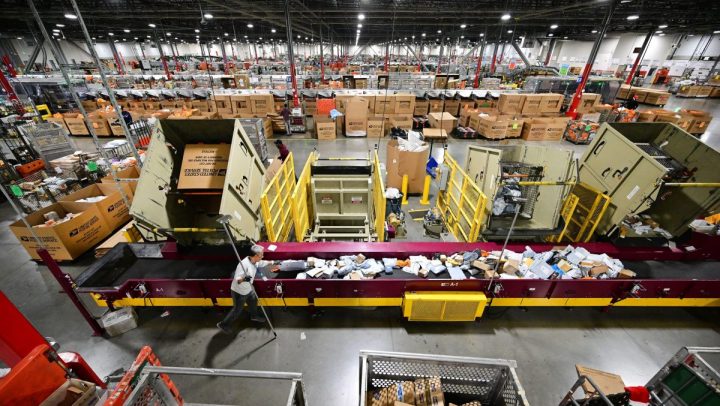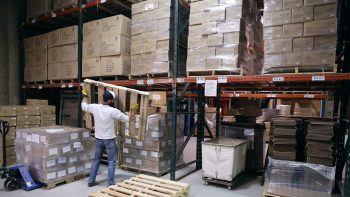
In California’s Inland Empire, the warehousing industry’s growth comes with consequences
In California’s Inland Empire, the warehousing industry’s growth comes with consequences

When we shop online, it can be easy to forget about what happens between the moment we click ‘buy’ and the moment the package shows up at our front door. But in some parts of this country, that stuff that happens in between is everything.
These are regions of the U.S. where transportation and warehousing has boomed over the last decade, thanks in large part to the growth of online shopping and promises of rapid delivery. In those areas, logistics is often the biggest employer — and sometimes, the most controversial industry.
One of those regions is California’s Inland Empire, a swath of land near Los Angeles where companies store, repackage and distribute goods coming in through the busy ports of L.A. and Long Beach.
On Hermosa Avenue in Rancho Cucamonga, roughly 40 miles east of downtown Los Angeles, trucks pull in and out of warehouses and distribution centers on either side of the street. Between Rancho Cucamonga and its neighboring city Ontario, roughly 100,000 trucks make trips like these every day, according to data from Pitzer College.
“That cumulative effect is part of what we’re interested in tracking,” said Susan Phillips, director of the Robert Redford Conservancy for Southern California Sustainability at Pitzer College.
A big concern, Phillips said, is the environmental impact of all this warehousing. Trucks spew out greenhouse gasses and particulate matter. Just a block away, the cluster of warehouses gives way to a residential neighborhood.
“You have this pattern of kids that maybe grew up with asthma, they’ve been breathing this air their whole lives, they’ve got trucks running up and down the street near where their school is,” Phillips said.
Warehouses first started popping up in the Inland Empire in the 1970s and 1980s, said Juliann Emmons Allison, a professor at U.C. Riverside who studies the warehousing industry. Back then, warehouses simply stored goods that came through the ports of Los Angeles and Long Beach.
“If you’re in Boston, and you buy something that comes through the port in Los Angeles, it has to come through this area and use all these warehouses and facilities and logistics,” Allison said.
Today’s warehouses are doing a lot more than just storing goods. Thanks to the growth of online shopping, especially in the last decade, pallets of goods have to be broken down, sorted, then repackaged so that they can be shipped out. As a result, Allison said warehouses have gotten a lot bigger.
“You needed to have these facilities that did a lot of different things, and could respond to people quickly — ‘I want a stapler, and a pillow, and a book, and I want it now,'” Allison said.
The number of warehouses in the Inland Empire has roughly doubled every decade since the 1980s, according to data from Pitzer College. Now, the industry employs over a quarter million people in the region, according to the Inland Empire Economic Partnership.
“It’s a real backbone for the economy throughout Southern California,” said Jon Switalski, executive director of the Rebuild SoCal Partnership, a group that advocates for infrastructure investment.
Switalski said the logistics industry’s growth has created more than just warehousing jobs.
“You now start to bring in corporate headquarters,” Switalski said. “You bring in different types of companies that want to service this industry. And so when you cluster that, there becomes exponential benefits.”
The boom in online shopping that happened during the pandemic helped turn transportation and warehousing into the Inland Empire’s biggest employer.
The jobs the industry offers also align with the skills of the region’s workers, according to Manfred Keil, an economics professor at Claremont McKenna College and chief economist at the Inland Empire Economic Partnership.
“The labor force does not have very high education levels,” Keil said. “And therefore, perhaps, it suits them very much to work in the logistics industry.”
But it isn’t likely to make them rich. Per capita income in the Inland Empire puts the region in the bottom quarter of metropolitan areas in the U.S. Keil says that’s because the transportation and warehousing industry just doesn’t pay as much as some others.
“As much as it has done for employment, it has done very little to average income,” Keil said.
The Labor Department says average pay in the transportation and warehousing sector is roughly $28.50 per hour. That’s lower than average pay in the manufacturing and construction industries. And, after all, that’s only a national average.
“I’m at $19 right now,” said Daniel Rivera, who works at an Amazon facility at the San Bernardino airport, where he moves packages on and off of planes and sorts them inside a warehouse.
Rivera said his pay only got to $19 an hour after workers at the facility went on strike last year, demanding raises and safer working conditions.
A spokesperson for Amazon, which operates several warehouses in the area — and is a Marketplace underwriter — said the national average for pay in the transportation and warehousing sector includes types of roles that Amazon doesn’t have, and that the company is proud of its competitive pay and comprehensive benefits.
But there’s another problem that could affect workers in the Inland Empire: Workers in the local economy rely on consumers in the national economy to keep buying goods. That makes the region particularly vulnerable to a recession, per Johannes Moenius, a professor at the University of Redlands.
“If more people are out of jobs, that means that they will not spend as much money, which then affects sales and related occupations,” Moenius said. “Then, they won’t get as much stuff from the warehouses. That means the transportation sector will be affected. Then, you don’t need as many people in-office and administrative support either.”
Plus, all the jobs the industry has created in the region might not last. Moenius has been researching how many of the region’s jobs could be automated with today’s technology. The answer? Almost two-thirds.
“We are the fourth most vulnerable metro in the nation,” Moenius said. “And the most vulnerable metro in California.”
Moenius added that it doesn’t mean it makes economic sense for employers to replace workers with robots right now. But as automation gets cheaper, that could change.
There’s a lot happening in the world. Through it all, Marketplace is here for you.
You rely on Marketplace to break down the world’s events and tell you how it affects you in a fact-based, approachable way. We rely on your financial support to keep making that possible.
Your donation today powers the independent journalism that you rely on. For just $5/month, you can help sustain Marketplace so we can keep reporting on the things that matter to you.

















